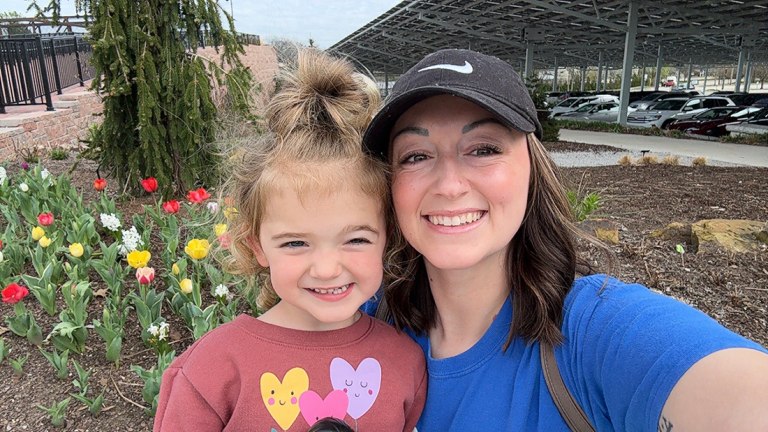Someday, Veronica Williams and her husband Sean will have quite the story to tell their daughter Brooklynn about her birthday. That day, when Brooklynn entered the world, her mom came close to leaving it.
It was March 9, 2022, weeks ahead of Brooklynn’s due date. For days, Veronica’s smartwatch had alerted her to an abnormally high heart rate. When she became short of breath, she assumed everything was pregnancy-related.
“I reached out to my obstetrician’s office, and they suggested I go to the emergency room,” Veronica says. “So we went, thinking it would be just a brief visit. But they couldn’t get my heart rate under control.”
A Uniquely Special Delivery
At first, doctors at St. Elizabeth Edgewood Hospital thought a blood clot was causing her issues. They took Veronica to the Cardiac Catheterization Lab to investigate. But the medicine they gave her to lower her heart rate, which exceeded 160 beats per minute, also affected her baby. With time of the essence, they performed an emergency cesarean section in the Cath Lab.
As Veronica’s condition deteriorated, Brooklynn was delivered at just 32 weeks. A team of nearly 50 specialists worked frantically to save the lives of mother and baby. There were times when Veronica’s heart stopped. And her survival was in doubt.
Eventually, with Brooklynn in the Neonatal Intensive Care Unit (NICU), and her mother’s heart failing and not responding to other treatments, doctors placed Veronica on an extracorporeal membrane oxygenation (ECMO) machine.
ECMO’s Role
ECMO takes over the work of your heart and lungs when they aren’t functioning well. It allows the organs to rest while you receive treatment — and, in Veronica’s case, while doctors worked to identify the cause of her condition. It can also buy time if you need a heart or lung transplant.
For heart conditions, ECMO involves inserting cannulas, or tubes, into an artery and vein. This allows blood to flow to and from the ECMO machine, where it’s oxygenated. Typically, doctors obtain access through the groin. But in Veronica’s case, that was impossible.
“She is such a small gal,” says George Christensen, DO, ECMO Program Medical Director. “The vessels in her groin were so small it was almost like a pediatric case, and we don’t do pediatric ECMO.”
This meant Dr. Christensen had to split her breastbone in a procedure called a sternotomy and initiate ECMO directly through the vasculature of her heart. Veronica was on ECMO for two days at St. Elizabeth. But concluding she would likely need a heart transplant, doctors moved her to a transplant hospital.
Precious Time
A biopsy on Veronica’s heart ultimately provided a cause for her problems — lymphocytic myocarditis. Doctors believe it resulted from a lingering cold. The condition caused a buildup of white blood cells, a key part of the body’s immune system, which inflamed her heart.
Armed with her diagnosis, doctors provided treatment that helped her improve and made a transplant unnecessary.
“When I first woke up, I had no idea that I had my daughter,” she says. “I thought I was still pregnant.”
When Brooklynn was delivered back at St. Elizabeth, team members put her in Veronica’s arms. They didn’t know if she would ever see her again. Veronica, of course, doesn’t remember that. But just over two weeks after her arrival at the hospital, when Veronica was discharged, she got another chance.
“I remember looking at her on the bed and she was a lot smaller than she looked in pictures, which was kind of scary,” Veronica recalls. “But it was a great feeling to be alive and to hold her.”
Roughly two weeks after Veronica’s discharge, Brooklynn was discharged, and mother and daughter were home together.
Returning to Normal
During treatment and recovery, Veronica took immunosuppressants. The drugs tamp down the immune system. Any illness she contracted then could have been deadly, so she had to be especially careful.
Today, she gets yearly heart checkups and takes blood pressure medicine. But otherwise, she’s back to normal. Still, doctors have told her she’s at risk of myocarditis in the future. So, that’s nerve-racking.
“I get a little bit freaked out anytime I have even a stuffy nose,” she says.
Living in the Moment
Even with her nerves, Veronica has a new way of looking at life.
“I really try to be in the moment,” she says.
Fortunately, there are plenty of moments with Brooklynn, who now is a feisty but healthy 3-year-old. When Veronica talks about Brooklynn, it’s obvious her heart, once so fragile, overflows with love.
“There are days where I look at her and I’m just so happy I get to be here and watch her grow up,” Veronica says. “It makes everything we do a little more special.”
To learn more about our exceptional Heart & Vascular services, visit Heart & Vascular | KY, OH & IN | St. Elizabeth Healthcare.

